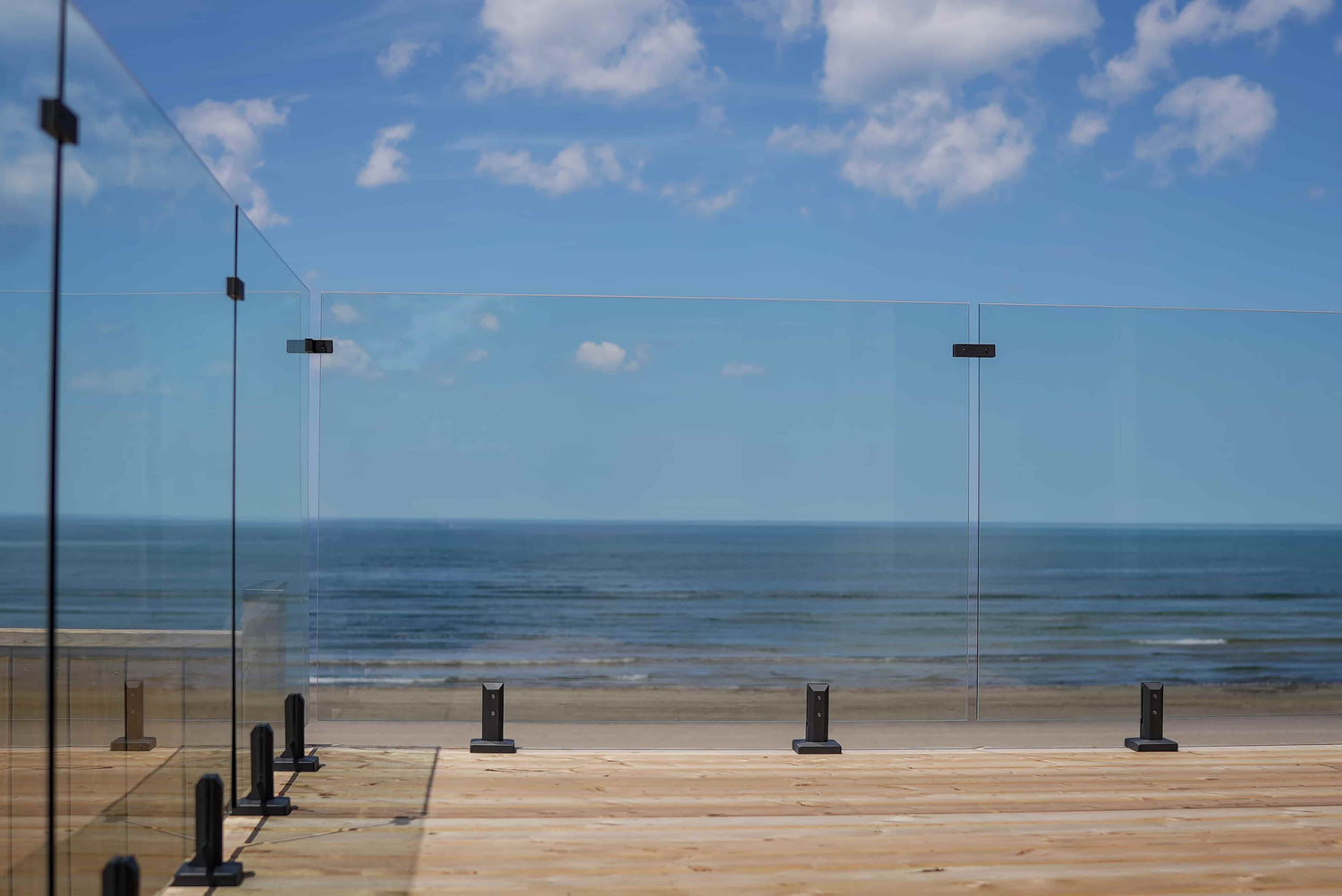Tennessee Building Code for Glass Railings: 2025 Complete Compliance Guide

Glass railing installation presents special difficulties for Tennessee builders and homeowners in the shadow of the Great Smoky Mountains, whose misty peaks soar over 6,000 feet and various ecosystems display nature's engineering prowess. The varied topography of the Volunteer State, which includes the Mississippi Delta and the Appalachian highlands, results in climate fluctuations that necessitate careful attention to construction code compliance.
Tennessee operates under a transitional building code system, moving from the 2012 International Building Code (IBC) to the 2021 IBC effective April 17, 2025. This creates a regulatory landscape where glass railing installations must navigate both existing 2012 standards and upcoming 2021 requirements, particularly crucial given Tennessee's diverse topography from mountain peaks to river valleys.
Understanding Tennessee's Building Code Framework
Tennessee's building code system reflects the state's diverse geography through the Tennessee Department of Commerce and Insurance oversight of the Tennessee State Fire Marshal's Office. The state transitions from 2012 IBC to 2021 IBC with an effective date of April 17, 2025, and a 120-day grace period extending to August 15, 2025 for projects submitted under previous codes. Major cities like Nashville, Memphis, Knoxville, and Chattanooga will align with 2021 IBC standards, though they may maintain local amendments exceeding minimum requirements. Nashville currently uses 2018 International Building Codes, while the statewide transition ensures consistent safety standards across Tennessee's varied terrain.
There are distinct environmental considerations for the plains of West Tennessee, the rolling hills of Middle Tennessee, and the mountains of East Tennessee. Stricter rules that affect glass railing specs, inspection, and permits can be implemented by local governments to address problems.
Glass Railing Safety Requirements and Standards
Tennessee's glass railing safety requirements center on IBC Section 2407, which mandates specific glazing standards for handrails and guards. All glass railings must utilize safety glazing meeting either Category I (16 CFR 1201) or Class A (ANSI Z97.1) standards, with laminated glass required for most guard applications. Structural load requirements follow IBC Section 1607.8 specifications, demanding glass railings withstand a 200-pound concentrated load applied at any point and direction, plus a 50-pound per linear foot uniform load applied horizontally along the top rail. Glass components must incorporate a 4x safety factor, meaning allowable stresses equal one-fourth of the material's ultimate strength.

ASTM E2353 test methods cover procedures for determining static strength, impact performance, and post-breakage characteristics of railing systems, providing the testing framework for compliance verification. These standards ensure glass railings maintain barrier function even after impact or breakage. Laminated glass construction with ethylene vinyl acetate (EVA) or polyvinyl butyral (PVB) interlayers is a feature of contemporary glass railing systems. Considering Tennessee's varied temperature zones, which result in differing thermal stress conditions, these materials offer better post-breakage performance than tempered glass alone.
Height and Dimensional Requirements
The height standards for glass railings in residential and commercial settings differ greatly. Commercial buildings must have guard heights of at least 42 inches above nearby walking surfaces, measured vertically from the top of the guard to the walking surface. Residential applications under the International Residential Code allow 36-inch heights for individual dwelling units, though many jurisdictions have adopted 42-inch minimums for consistency. Opening restrictions mandate that no opening allow passage of a 4-inch diameter sphere, particularly critical between 2 inches and 43 inches above adjacent surfaces.
|
Application Type |
Minimum Height |
Load Requirements |
Opening Limits |
|
Residential Guards |
36" (some jurisdictions 42") |
200 lbs concentrated + 50 lbs/linear foot |
4" sphere cannot pass |
|
Commercial Guards |
42" |
200 lbs concentrated + 50 lbs/linear foot |
4" sphere cannot pass |
|
Stair Guards |
34" minimum |
Same as above |
4 3/8" sphere cannot pass |
|
Handrails |
34"-38" (graspable) |
200 lbs. concentrated + 50 lbs./linear foot |
Not applicable |
Important design considerations arise from top rail requirements. Top rails or handrails must be joined to structural glass balusters, and at least three glass baluster panels must support the top rail. However, when the glass is composed of two or more plies of equivalent thickness and passes ASTM E2353 testing for glazing performance in permanent railing systems, laminated glass systems may be able to do away with top rails.
Permitting and Inspection Process
Tennessee's centralized oversight system through the State Fire Marshal's Office creates structured permitting requirements across jurisdictions. Nashville's Department of Codes and Building Safety ensures construction projects comply with local and state building codes through reviewing building plans, conducting inspections, and enforcing relevant regulations.
Required documentation typically includes:
- Complete building permit applications with project details
- Detailed construction plans showing glass railing specifications
- Engineer-sealed structural calculations for load-bearing elements
- Material specifications with safety glazing certifications
- Installation details showing connection methods and support systems
Inspection processes adhere to established protocols: pre-installation inspections validate adequate framing and structural supports; installation inspections verify correct glass placement and safety compliance; and final inspections guarantee that finished work corresponds with authorized designs. The majority of jurisdictions demand that inspections be scheduled with a 24-hour notice. In places where local construction codes are not enforced, residential permits are provided by the State Fire Marshal's Office.
Material Specifications and Testing
The various temperature zones in Tennessee necessitate careful consideration of the material criteria for glass railings. Different performance requirements are created by temperature and humidity changes, ranging from the humid subtropical conditions of Middle and West Tennessee to the mountain temperate climate of East Tennessee. For simple uses, the minimum glass thickness is 1/4 inch; however, in Tennessee's diverse temperature zones, 3/8-inch or 1/2-inch thickness offers superior performance. Compared to monolithic tempered glass, laminated glass systems with the right interlayer materials perform better.
Testing requirements center on ASTM E2353 procedures covering static strength, impact resistance, and post-breakage characteristics. These test methods address the capability of glass or other glazing material to continue functioning as a barrier by remaining in the designed framing system after impact or glazing breakage. Professional glass railing systems often provide pre-tested components meeting ASTM requirements, simplifying compliance verification. Custom installations may require project-specific testing to demonstrate code compliance under both current and upcoming Tennessee requirements. Permanent marking requirements mandate each glass pane include manufacturer identification, glass type and thickness, manufacturer or installer name, and safety glazing standard compliance markings.

Installation Best Practices for Tennessee Climate
Because of its varied terrain, Tennessee necessitates specific installation methods that take into consideration variations in height, humidity, and storm patterns. From the high-elevation woods of the Great Smoky Mountains to the river plains of the Mississippi Delta, installation techniques must take into account a variety of environmental conditions. Deflection restrictions of L/175 for span length under design loads and a maximum of 1/8-inch horizontal sill deflection owing to glass weight are standards for the framing system. These restrictions avoid excessive movement that can damage glass panels or jeopardize weathersealing in Tennessee's diverse landscape.
Setting block requirements follow Glass Association of North America (GANA) guidelines, specifying 100% silicone blocks with 85±5 durometer hardness. These blocks support glass weight while allowing thermal movement, crucial for long-term performance across Tennessee's varied climate conditions. Weather sealing demands attention to wind-driven moisture that can penetrate inadequately sealed systems. Tennessee's storm patterns, from mountain thunderstorms to valley flooding, create challenging conditions requiring robust sealing systems and proper drainage design. Specialized glass railing suppliers understand these region-specific requirements and can provide systems designed for Tennessee's diverse geographic and climatic conditions.
Residential vs Commercial Requirements
Glass railing installations in homes and businesses are subject to different standards set forth by Tennessee building codes. More adaptable methods are made possible by residential applications under the International Residential Code, especially for single-family dwellings in Tennessee's many areas. Commercial applications must meet stringent IBC requirements including 42-inch minimum guard heights, enhanced load requirements, and comprehensive accessibility compliance. The Americans with Disabilities Act (ADA) mandates specific handrail requirements that may necessitate separate handrail systems in addition to glass guards.
Both residential and commercial installations are impacted by wind load factors. Because of its diverse topography, Tennessee has varying degrees of wind exposure, necessitating improved anchoring and structural construction. When selecting glass railing components, consider both code requirements and regional environmental conditions to ensure optimal performance across Tennessee's diverse geographic zones.
Recent Code Updates and Future Changes
Tennessee's transition from 2012 IBC to 2021 IBC represents significant regulatory advancement, introducing refined requirements for glass railing systems throughout the state. ASTM standard updates provide improved testing procedures and performance criteria. Professional development remains crucial for contractors and installers working with glass railing systems during Tennessee's regulatory transition period. Industry associations provide valuable resources for staying current with code changes and best practices.

Conclusion
While recognizing the particular difficulties presented by various geographic regions, Tennessee's glass railing building code regulations demonstrate the state's dedication to safety via the impending 2021 IBC adoption. Glass railings must resist the diverse environmental conditions of the Volunteer State and meet changing safety standards, whether they are installed on the river plains of West Tennessee or the foggy summits of the Great Smoky Mountains. Professional design and installation services, thorough documentation throughout the project lifetime, and early cooperation with local building inspectors knowledgeable about the 2021 IBC changeover are all critical success elements. Contractors and property owners need to be aware of the 120-day grace period for ongoing projects and stay updated on the April 17, 2025 transition.
Frequently Asked Questions
1. Does Tennessee require building permits for glass railing installations?
Permit requirements vary by jurisdiction. Major cities like Nashville require permits for deck construction and structural modifications. The State Fire Marshal's Office provides residential permitting for areas without local building code enforcement.
2. What type of glass must be used for railings in Tennessee?
All glass railings must use safety glazing meeting either Category I (16 CFR 1201) or Class A (ANSI Z97.1) standards. Laminated glass is required for most guard applications.
3. How does Tennessee's geographic diversity affect glass railing performance?
Tennessee's varied topography from mountain peaks to river valleys creates different climate conditions requiring tailored installation techniques and appropriate material selection.
4. What load requirements must glass railings meet in Tennessee?
Glass railings must withstand 200-pound concentrated loads applied at any point plus 50-pound per linear foot uniform loads applied horizontally.
5. How does the 2021 IBC transition affect glass railing projects?
A: The transition becomes effective April 17, 2025, with a 120-day grace period until August 15, 2025. Projects submitted under current codes during this period maintain approval.
6. Are there specific requirements for different Tennessee regions?
While statewide codes apply uniformly, local jurisdictions may impose additional requirements based on geographic conditions like mountain wind loads or valley flooding concerns.
7. How long does the permit and inspection process take?
Timeline varies by jurisdiction. Plan review typically takes 1-2 weeks, while inspections require 24-hour advance notice. The transitional code period may extend review time
8. Do glass railings need special maintenance in Tennessee's varied climate?
Regular inspection and maintenance help ensure long-term performance across Tennessee's diverse conditions. Check weather seals, structural connections, and glass condition seasonally.
Let customers speak for us

Glass Railing Near You
Discover how The Glass Railing Store has been delivering exceptional service to our customers, thanks to our dedicated and knowledgeable team and their love our glass railing products.







